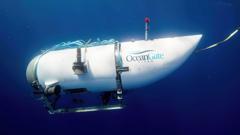PORTLAND, Maine—The National Transportation Safety Board (NTSB) has concluded in a report released Wednesday that faulty engineering was the primary cause of the Titan submersible's catastrophic implosion, which occurred in June 2023. The incident tragically claimed the lives of five individuals as they attempted to explore the Titanic wreck site in the North Atlantic.
The NTSB's final report highlighted significant engineering flaws in the Titan's construction, noting that the carbon fiber composite pressure vessel had multiple anomalies that fell short of required strength and durability standards. Furthermore, OceanGate, the company behind the Titan, was criticized for failing to conduct adequate testing, leaving it unaware of the vessel's true durability.
The report also suggested that the Titan might have been located earlier, potentially conserving valuable time and resources, if the company had adhered to standard emergency response protocols. This finding aligns with a Coast Guard report from August, which labeled the Titan's implosion as preventable due to glaring lapses in safety practices at OceanGate.
OceanGate suspended its operations shortly after the incident, and while the company did not respond to queries on the report, a spokesperson had previously expressed condolences to the victims' families. The implosion claimed the lives of notable figures including CEO Stockton Rush and renowned deep-sea explorer Paul-Henri Nargeolet, among others, sparking lawsuits and calls for enhanced regulatory measures.
The NTSB has recommended that the Coast Guard form an expert panel to evaluate submersibles and other human-occupied pressure vehicles, urging the establishment of regulatory frameworks based on their findings. This incident underscores the alarming growth of private deep-sea exploration, highlighting the need for rigorous safety standards in this expanding industry.
The NTSB's final report highlighted significant engineering flaws in the Titan's construction, noting that the carbon fiber composite pressure vessel had multiple anomalies that fell short of required strength and durability standards. Furthermore, OceanGate, the company behind the Titan, was criticized for failing to conduct adequate testing, leaving it unaware of the vessel's true durability.
The report also suggested that the Titan might have been located earlier, potentially conserving valuable time and resources, if the company had adhered to standard emergency response protocols. This finding aligns with a Coast Guard report from August, which labeled the Titan's implosion as preventable due to glaring lapses in safety practices at OceanGate.
OceanGate suspended its operations shortly after the incident, and while the company did not respond to queries on the report, a spokesperson had previously expressed condolences to the victims' families. The implosion claimed the lives of notable figures including CEO Stockton Rush and renowned deep-sea explorer Paul-Henri Nargeolet, among others, sparking lawsuits and calls for enhanced regulatory measures.
The NTSB has recommended that the Coast Guard form an expert panel to evaluate submersibles and other human-occupied pressure vehicles, urging the establishment of regulatory frameworks based on their findings. This incident underscores the alarming growth of private deep-sea exploration, highlighting the need for rigorous safety standards in this expanding industry.


















